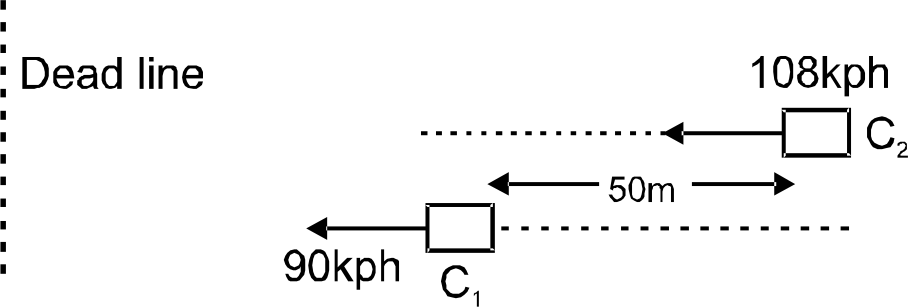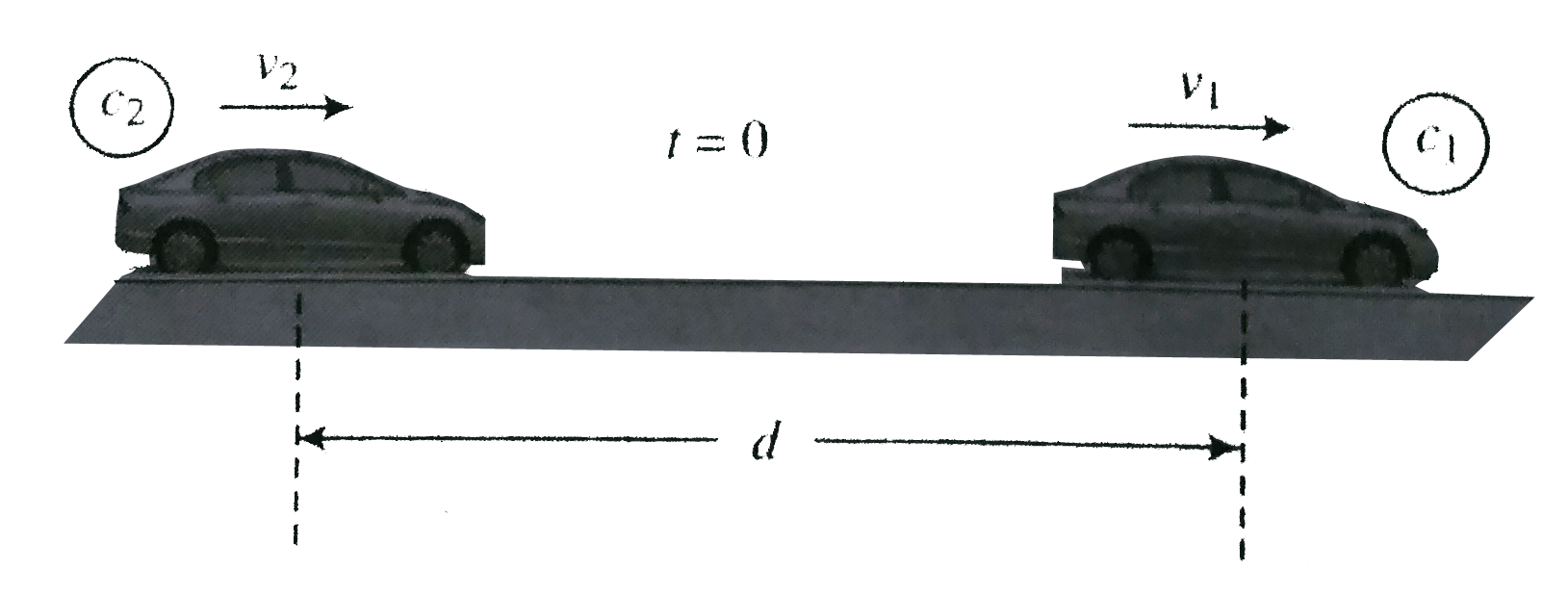Two cars C1&C2 are moving in parallel lanes in the same direction at speeds 90kph&108kph respectively (see figure). As the traffic signal turns red, both applies brake (assume constant retardation) simultaneously. If they both stop together at the dead line

distance of dead line from C2 is 300m
destance of dead line from C1 is 250m
time taken by the cars to ends up after the signal turn red is 15sec.
time taken by the cars to ends up after the signal turn red is 20sec.
The correct Answer is:A::B::D
(i) Relative initial velocity =5m/s, relative final velocity =0
Relative displacement =50m
Relative acceleration = constant
⇒50=(5+02)t⇒t×20sec.
(ii) Distance of dead line from car C1=(25+02)×20=250m.
Topper's Solved these Questions
Similar Questions
Two cars 1 and 2 move with velocities v1 and v2, respectively, on a straight road in same direction When the crs are separated by a destance d the driver of car 1 applies brakes and the car moves with uniform retardation a1, Simultaneously, car 2 starts accelerating with a2, If v1<v2, find the minimum initial separation between the cars to avoid collision between then.
View SolutionTwo trains A and B start running together from the same point in the same direction, at the speeds of 60 kmph and 72 kmph respectively. if the length of each of the trains is 240 metres,, how long will it take for train B to cross train A? 1min2 secs b. 1min24 sec c. 2min12 secs d. 2min24 secs
View Solution
Knowledge Check
- Question 1 - Select One
Two cars C1 and C2 are moving on parallel roads in the same direction with velocity v. The relative of C1 w.r.t. C2 is :
ADirection towards C2BDirection towards C1CZeroD2v - Question 2 - Select One
Two vehicles C1andC2 start from a point P and travel east of P at the speeds 20 km/hr and 60 km/hr respectively. If an observer, one kilometre north of P, is able to see both the vehicles at the same time, then the maximum angle of sight between the observer's view of C1andC2, is :
Aπ3Btan−1(2√3)Cπ6Dtan−1(√32)
Two particles of mass 1kg and 2kg are moving along the same line with speeds 2m/s and 4m/s respectively. Calculate the speed of the centre of mass of the system if both the particles are moving in the same direction.
View SolutionTwo trains A and B are moving on same track in opposite direction with velocity 25m/s and 15,m/s" respectively.When separation between them becomes 225m drivers of both the trains apply brakes producing uniform retardation in train A while retardation of train B increases linearly with time at the rate of 0.3m/s^(3).The minimum retardation of train A to avoid collision will be
View SolutionTwo particle of mass 2kgand1kg are moving along the same straight line with speeds 2m/sand5m/s respectively. What is the speed of the centre of mass of the system if both the particles are moving (a) in same direction (b) in opposite direction ?
View SolutionTwo cars C1 and C2 moving in the same direction on a straight single lane road with velocities v1=12ms−1 and v2=10ms−1, respectively . When the separation between the two was d=200m, C2 started accelerating to avoid collision. What is the minimum acceleration of car C2 so that they do not collide?
 .View Solution
.View SolutionTwo parallel forces F1 and F2 acting in the same direction are applied to a rigid body.
Porve that
(a) the magnitude of the resultant force is equal to the sum of magnitudes of the forces being added,
(b) the resultant force is parallel to the forces being added and acts in the same direction,
(c ) the resultant force passes through the centre of the parallel forces, i.e. through the point which divides the distance between the points of application of both forces into sections inversely proportional to the magnitude of the forces.View SolutionA smooth spherical ball of mass M = 2 kg is resting on two identical blocks A and B as shown in the figure. The blocks are moved apart with same horizontal velocity V = 1 m/s in opposite directions (see figure).
(a) Find the normal force applied by each of the blocks on the sphere at the instant separation between the blocks is a=√2R, R = 1.0 m being the radius of the ball.

(b) How much force must be applied on each of the two blocks (when a=√2R) so that they do not have any acceleration. Assume that the he horizontal surface is smooth.View Solution

